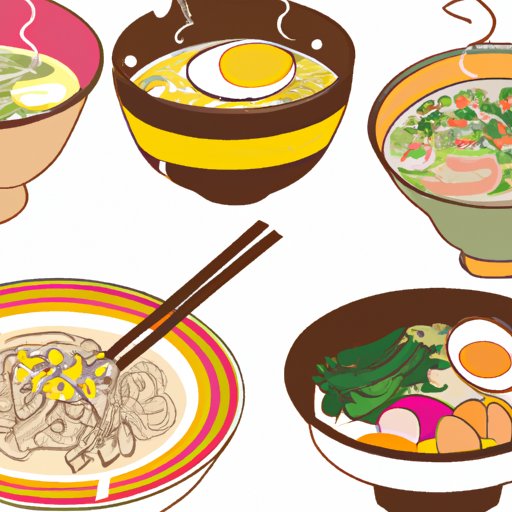Introduction
Ramen is a type of Japanese noodle dish made with wheat-based noodles, broth, and a variety of toppings like vegetables, meats, and eggs. It’s quick, easy to make, and very affordable, which is why it’s become a popular meal choice for people of all ages. But is ramen actually healthy? In this article, we’ll explore the nutritional value of ramen, potential risks associated with eating it, and tips for making a healthier version.

Exploring the Health Benefits and Risks of Eating Ramen
When it comes to evaluating the healthfulness of any food, you have to look at both the benefits and risks associated with it. So let’s take an in-depth look at what makes up a bowl of ramen and how it can affect your health.
Nutritional Value
The first thing to consider when looking at the healthfulness of ramen is the nutritional value. Most bowls of ramen include ingredients like wheat-based noodles, broth, and a variety of toppings like vegetables, meats, and eggs. These ingredients provide a range of essential vitamins and minerals, as well as some protein and fiber.
Potential Risks
On the other hand, ramen can also contain high levels of sodium, saturated fat, and processed carbohydrates, which can increase your risk of certain health conditions if consumed in large amounts. Additionally, many store-bought varieties of ramen contain preservatives and artificial flavorings, which can be unhealthy in large amounts.
A Nutritionist’s Guide to Enjoying Ramen Without Compromising Your Health
So how can you enjoy a bowl of ramen without compromising your health? Here are some tips from nutritionists to keep in mind:
Choosing the Right Ingredients
When it comes to choosing the right ingredients for your ramen, opt for fresh, whole ingredients whenever possible. Look for fresh vegetables, lean proteins like chicken or fish, and low-sodium broths. You can also add in some healthy fats like avocado or nuts for added flavor and texture.
Moderation and Balance
It’s also important to remember that moderation is key when it comes to eating ramen. Even if you choose the healthiest ingredients, eating too much of it can still be unhealthy. Aim to limit your intake of ramen to once or twice a week, and make sure to balance it with plenty of other nutrient-dense foods throughout the day.
An In-Depth Look at the Nutritional Value of Ramen
Now let’s take a closer look at the nutritional value of ramen. The exact nutritional content of your ramen dish will depend on the ingredients used, but here are some general guidelines to keep in mind.
Calories and Macronutrients
Most bowls of ramen contain around 500-700 calories, depending on the ingredients used. They are also a good source of macronutrients like carbohydrates, protein, and fat. The exact amount of each macronutrient will vary depending on the ingredients used, but most bowls of ramen contain around 20-30 grams of carbohydrates, 15-20 grams of protein, and 5-10 grams of fat.
Vitamins and Minerals
Ramen is also a good source of essential vitamins and minerals. It contains Vitamins A, C, and E, as well as iron, calcium, magnesium, and potassium. Again, the exact amounts of each vitamin and mineral will vary depending on the ingredients used.
Other Components
Finally, ramen may also contain small amounts of other components like dietary fiber and cholesterol. Again, the exact amounts will vary depending on the ingredients used.
Unpacking the Pros and Cons of Eating Ramen
Now that we’ve taken a closer look at the nutritional value of ramen, let’s unpack the pros and cons of eating it.
Pros
The biggest pro of eating ramen is that it provides a range of essential vitamins and minerals. Additionally, it’s a convenient and affordable meal option for those on a budget. Finally, it can be a great way to get creative in the kitchen and experiment with different flavors and ingredients.
Cons
On the other hand, ramen can also be high in sodium, saturated fat, and processed carbohydrates, which can increase your risk of certain health conditions if consumed in large amounts. Additionally, many store-bought varieties of ramen contain preservatives and artificial flavorings, which can be unhealthy in large amounts.
Is Ramen Actually Healthy? We Investigate..
So is ramen actually healthy? To answer this question, we need to look at what the research says. According to a study published in the journal Nutrition Reviews, eating ramen in moderation can be part of a balanced diet. However, the study also found that consuming too much ramen can increase your risk of developing obesity, diabetes, and other chronic diseases.
Tips for Making a Healthy Ramen Dish
If you want to enjoy a bowl of ramen without compromising your health, there are a few simple steps you can take. First, opt for fresh, whole ingredients whenever possible. Second, aim to limit your intake of ramen to once or twice a week. And finally, remember to balance it with plenty of other nutrient-dense foods throughout the day.
Conclusion
In conclusion, ramen can be part of a healthy diet as long as it’s enjoyed in moderation. When it comes to choosing the right ingredients, opt for fresh, whole foods whenever possible. Remember to limit your intake of ramen to once or twice a week, and make sure to balance it with plenty of other nutrient-dense foods throughout the day. With these tips in mind, you can enjoy a bowl of ramen without compromising your health.
(Note: Is this article not meeting your expectations? Do you have knowledge or insights to share? Unlock new opportunities and expand your reach by joining our authors team. Click Registration to join us and share your expertise with our readers.)
